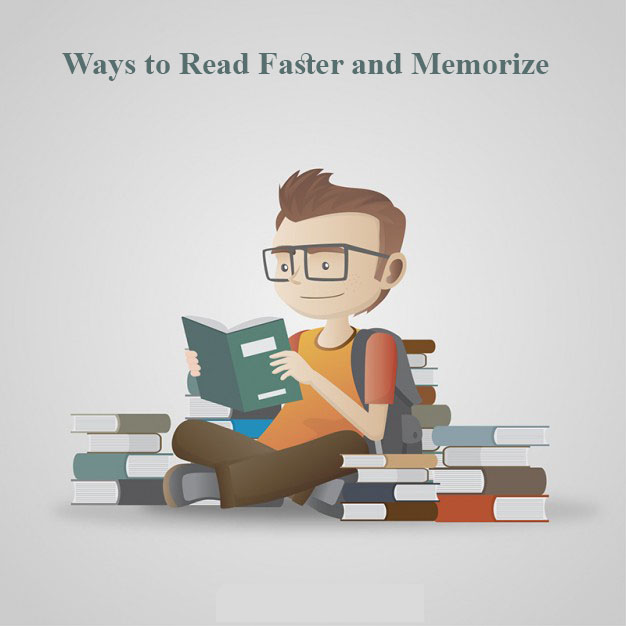
By Dennis Doyle
For most people, it is easy to learn to read faster. Your reading rate is often just a matter of habit. But to begin, you may need to try to change some habits and try these tips:
5 Easy Ways to Read Faster and Memorize
1. Pay attention:
When you read and read as if it really matters. Most people read in the same way that they watch television, i.e. in an inattentive, passive way. Reading takes effort and you must make the effort. A wise teacher once told me that you can learn anything if you do three things:
PAY ATTENTION, PAY ATTENTION and PAY ATTENTION.
There are some simple methods that you can use to pay better attention and get more out of your textbook reading time. Different authors call it different things, but many researchers say that you will improve your comprehension if you somehow “preview” the passage before you actually sit down and read every word.
To do a preview you:
- Take 30 to 60 seconds.
- Look over the title of the chapter.
- Look at all the headings, subheadings and marked, italic or dark print.
- Look at any pictures or illustrations, charts or graphs.
- Quickly skim over the passage, reading the first and last paragraph and glancing at the first sentence of every other paragraph.
- close the book and ask yourself:
- —What is the main idea?
- —What kind of writing is it?
- —What is the author’s purpose?
You might not think that you could possibly answer these questions with so little exposure to the material, but if you do the preview correctly, you should have some very good general ideas. If you have a general idea of what the passage is about before you really read it, you will be able to understand and remember the passage better.
When you finally get to the point where you are actually slowly reading the passage, read in a “questioning” manner -as if you were searching for something. It sometimes helps if you take the heading or title of a chapter and turn it into a question.
For example, if the heading of a section in the text is “The Causes of the Civil War”, take that title and switch it into a question like: “What are the causes of the Civil War?”. Now you have a goal; something to look for; something to find out. When you are goal-oriented, you are more likely to reach the goal. At least you’ll remember one thing about the text which you have just read.
2. Stop talking to yourself when you read.
People talk to themselves in 2 ways, by:
- vocalizing, which is the actual moving of your lips as you read, and
- Sub vocalizing, which is talking to yourself in your head as you silently read.
Both of these will slow you down to the point in which you find that you can’t read any faster than you can speak. Speech is a relatively slow activity; for most, the average speed is about 250 WPM (words per minute).
Reading should be an activity which involves only the eyes and the brain. Vocalization ties reading to actual speaking. Try to think of reading as if you were looking at a landscape, a panorama of ideas, rather than looking at the rocks at your feet.
3. Read in thought groups.
Studies have shown that when we read, our eyes must make small stops along the line. Poor readers make many, many more fixations (eyes tops) than good readers. Not only does this slow you down, but it inhibits comprehension because meaning is easier to pull from groups of words rather than from individual words or even single letters. Try to read in phrases of three or four words, especially in complete clauses and prepositional phrases. Your mind may internalize them as if the whole phrase is like one big meaning-rich word.
4. Don’t keep re-reading the same phrases.
Poor readers habitually read and re-read the same phrase over and over again. This habit of making “regressions” doubles or triples reading time and often does not result in better comprehension. A single careful, attentive reading may not be enough for full comprehension, but is often more effective than constant regressions in the middle of a reading. It is best to work on paying closer attention the first time through. Do a preview first before the careful reading and try the tips I mentioned above. You’ll remember better without the rereading.
5. Vary your reading rate
To suit the difficulty and type of writing of the text. Poor readers always read at the same slow rate. An efficient reader speeds up for easier material and slows down for the hard. Some things were not meant to be read quickly at all. Legal material and very difficult text should be read slowly. Easier material and magazines and newspapers can be read quickly. Poetry and plays were meant to be performed, and if not acted out, then at least, spoken out loud orally. This obviously will conflict with good speed reading method which forbids vocalization. Religious writings and scripture were originally written to be recited and listened to by an audience which was likely to be intelligent, but illiterate. The “fun” of poetry, plays, or prayer is not really experienced if you “speed read” the text.
Searches related to how to read fast
how to read faster app
how to read faster and retain information
how to read faster and understand
how to read without subvocalizing
how to read faster reddit
how to read faster book
how to read faster and better by norman lewis pdf
how to read fast and memorize
